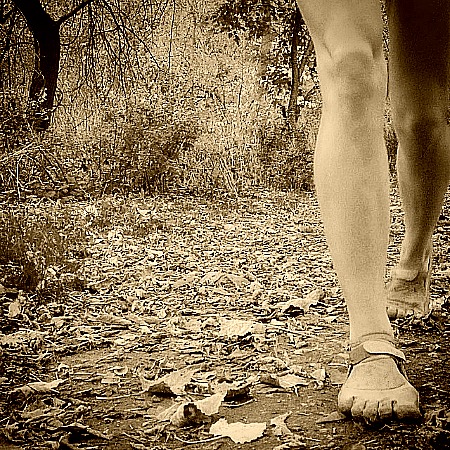One of the main differences between forefoot runners and heel strike runners is not only in their preferred footwear, but the extent to which they use their lower leg muscles.
In heel strike running, movement behaviors are influenced by the standard running shoe which in turn produces an unintended result –muscle overuse syndromes.
Over and over again, heel strike runners seem to struggle with more injuries than forefoot runners. A lot of injuries are biomechanically-based in heel strike running because the inappropriate windless use of the foot influences many muscular overuse injuries of the lower leg.
Moreover, the footwear heel strikers wear have elevated heels which produces a conflict situation during running: a high inclination angle of the foot, which is associated with unfavorable outcomes at touchdown.
Cushioned Heeled Running Shoes = Fatigue
The standard running shoe causes the foot to rest on a high inclination angle at heel strike. In this position, there is a rapid spike in EMG activity in the tibialis anterior, which increases in frequency and intensity with speed.
Nonetheless, bigger and stronger frequencies in EMG activity does indeed lead to muscle overuse syndrome in the anterior compartment. If it didn’t, then humans would avoid shin injuries by a way of adaptively managing prolonged muscle activity. Humans have not adopted a strategy for tackling this, hence the high incidence of shin splints in heel strike runners.
One thing is clear –although research on barefoot running shoes is in its infancy, it has already turned up a wealth of information about the improvements it has on leg pain and function. The most fundamental difference-maker is the relationship between barefoot running shoes and forefoot running.
Forefoot Running + Barefoot Running Shoes = Less Muscle Activity
 Forefoot running in itself involves a significantly smaller foot inclination angle at touchdown compared to heel strike running. Forefoot running is a behavioral response, akin to that which results from barefoot running or running in barefoot running shoes.
Forefoot running in itself involves a significantly smaller foot inclination angle at touchdown compared to heel strike running. Forefoot running is a behavioral response, akin to that which results from barefoot running or running in barefoot running shoes.
Presumably, forefoot running is an adaptive response to an unprotected heel under barefoot or barefoot shod conditions. Thus, a forefoot strike is a strategy to prevent heel pain during running. Moreover, a relaxed foot/ankle complex at touchdown seems to govern the process of avoiding heel strike in forefoot running thereby preventing muscle overuse syndromes.
More careful analysis of foot/ankle kinematics in forefoot running reveals that the long toe extensors are more relaxed at touchdown compared to heel strike running. When these muscles relax, EMG activity is low, suggesting that these muscles are less likely affected by overuse syndromes.
A study by Daoud et al. also found that a low foot inclination angle at touchdown increased cadence. Researchers have found that increased cadence reduces tibial angle at foot strike, promoting a flatter, smoother contact of the foot with the ground.
It is becoming more obvious that natural selection chose forefoot running based on it’s rewards and avoiding the wrong type of footwear is a guide to improvement in heel strike runners suffering from overuse injuries.
More From Run Forefoot:
- Why Run Forefoot?
- Rocker Shoes
- What Influences Foot Strike?
- Reviews on Barefoot Running Shoes
- Always Wear Wide Running Shoes
You Might Also Like:
References:
Daoud AI, Geissler GJ, Wang F, et al. Foot strike and injury rates in endurance runners: a retrospective study. Med Sci Sports Exerc. 2012;44:1325–34.
Heiderscheit BC, Chumanov ES, Michalski MP, et al. Effects of step rate manipulation on joint mechanics during running. Med Sci Sports Exerc 2011;43:296–302.
Miller AF., Roberts A., Hulse D and Foster J. Biomechanical overload syndrome: defining a new diagnosis. Br J Sports Med, 2014; 48:415-416.
Pohl MB, Rabbito M, Ferber R. The role of tibialis posterior fatigue on foot kinematics during walking. J Foot Ankle Res 2010;3:6.
Bretta Riches
BSc Neurobiology; MSc Biomechanics candidate, ultra minimalist runner & founder of RunForefoot. I was a heel striker, always injured. I was inspired by the great Tirunesh Dibaba to try forefoot running. Now, I'm injury free. This is why I launched Run Forefoot, to advocate the health & performance benefits of forefoot running and to raise awareness on the dangers of heel striking, because the world needs to know.
Latest posts by Bretta Riches (see all)
- How to Train Yourself to Not Heel Strike When Running - 24/04/2024
- Cushioned Running Shoes Found to Be Bad for Ankles - 23/04/2024
- Forefoot Running and Achilles Pain - 19/04/2024

Leave a Reply